Table of Contents
Introduction
In the religious and cultural landscape of India, Maharashtra’s Pandharpur Yatra holds a special place. It is not merely a pilgrimage but a living tradition of devotion, discipline, and social unity. Every year, millions of devotees become “Warkaris,” journeying on foot toward Pandharpur with unwavering faith and dedication. This pilgrimage is a confluence of the saints’ legacy, devotional literature, and the spiritual current of folk life.
Where Is Pandharpur Located and Why Is It Famous?
Pandharpur is a prominent pilgrimage site situated on the banks of the Bhima River in Solapur district, Maharashtra. It is famous for the temple of Lord Vitthal (Vithoba) and his consort Goddess Rukmini. Often referred to as the “Kashi of the South,” Lord Vitthal is considered a form of Lord Krishna, and this place is especially renowned for the Wari tradition.
When Did the Pandharpur Wari or Yatra Begin?
First Mentions in Ancient Scriptures:
References to Pandharpur are found in ancient texts like the Skanda Purana, where Vitthal is described as a regional deity. However, the detailed descriptions of an organized pilgrimage or Wari appear more clearly in the later devotional literature.
When Did the Mass Pilgrimage Begin?
Initially, this journey was undertaken individually or as a family tradition. Over time, inspired by saints and the influence of the Bhakti movement, it evolved into an organized pilgrimage. Especially between the 13th and 17th centuries, it took the form of a people’s movement.
Growth of the Yatra through the Bhakti Movement:
The Bhakti movement provided spiritual strength to this pilgrimage. Great saints like Sant Namdev, Sant Dnyaneshwar, Sant Eknath, and Sant Tukaram transformed it into a spiritual and social revolution.
Read Also: Pandharpur Wari 2025: Date, Route Map, Tradition.
Devshayani Ashadhi Ekadashi 2025: date,tithi, Significance, Rituals, and Worship Practices
Sant Namdev and His Role
Sant Namdev (13th century) was one of the earliest inspirations for the Pandharpur Yatra. He did not view Vitthal merely as a temple deity but as a close companion and divine friend. His abhangs and devotional hymns frequently mention Pandharpur and Vitthal. It is said that he regularly visited Pandharpur and spread the essence of this pilgrimage through his poetry.
The Traditions of Sant Dnyaneshwar and Sant Tukaram
Sant Dnyaneshwar:
Sant Dnyaneshwar (1275–1296) promoted the tradition of walking from Alandi to Pandharpur. His work Dnyaneshwari laid the philosophical foundation of the Bhakti movement. He considered Vitthal as a yogic deity and preached that true devotion knows no discrimination.
Sant Tukaram:
Sant Tukaram (17th century) popularized the Wari tradition from Dehu. His abhangs reflect simplicity and the ease of devotion to Vitthal. Through phrases like “Tuka Mhane” (Tuka says), he shared his spiritual experiences and transformed the Wari into a mass movement.
Beginning of the Palanquin Tradition and Its History
Origin of the Palkhi Tradition:
“Palkhi” refers to the sacred tradition of carrying the sandals (padukas) of saints in a palanquin. This practice began in the 17th century when the padukas of Sant Dnyaneshwar and Sant Tukaram were ceremoniously taken from their samadhis (shrines) to Pandharpur.
The Foot Journey and Palkhi:
Even today, this journey starts from Alandi (Dnyaneshwar Maharaj) and Dehu (Tukaram Maharaj) and continues to Pandharpur. Thousands of Warkaris walk along with the Palkhi, singing devotional hymns and offering service with great fervor. The journey lasts around 21 days.
Traditions and Devotee Communities Participating in the Wari
The Wari is organized by the Warkari Sampradaya, whose key features include:
- Abhang Singing: Devotional songs composed by saints
- Selfless Service: Serving others without expectations
- Equality: No discrimination based on caste, religion, or class
- Collectivity and Discipline: Emphasis on unity, decorum, and order
People from all walks of life — farmers, homemakers, students, elders, women — participate equally in the Wari.
Continuity of the Yatra from History to Present
During British rule, the Wari faced several obstacles. Authorities often attempted to suppress it, but the dedication and organization of Warkaris ensured its survival. After independence, the yatra gained more institutional support. Today, the Maharashtra government and various social organizations help facilitate the pilgrimage smoothly.
Social and Cultural Role of the Wari Tradition
The Wari is not just a religious ritual but a medium of social transformation. It:
- Provides a platform for rural communities
- Encourages social unity and fraternity
- Spreads harmony through devotion and service
- Keeps Maharashtra’s folk culture alive
Conclusion: A Confluence of Faith, History, and Tradition
The Pandharpur Yatra is not merely a religious practice — it is the very soul of Maharashtra. It embodies faith, the voice of saints, the dedication of rural people, and the unity of society. Though centuries old, its relevance remains undiminished. This yatra teaches us that true devotion, service, and equality are the threads that bind society together.
Jay Jay Ram Krushna Hari!
Whatsapp Channel Link :–https://whatsapp.com/channel/0029VbB0KvuIHphFXKcwyq3B
Click Here To Read In Hindi: पंढरपुर वारी की शुरुआत कैसे और कब हुई थी?| Pandharpur Vari ki Shuruvat Kab aur Kaise Hui.



